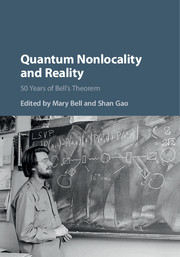Book contents
- Frontmatter
- Contents
- Contributors
- Preface
- Preface
- Part I John Stewart Bell: The Physicist
- Part II Bell's Theorem
- Part III Nonlocality: Illusion or Reality?
- 9 Strengthening Bell's Theorem: Removing the Hidden-Variable Assumption
- 10 Is Any Theory Compatible with the Quantum Predictions Necessarily Nonlocal?
- 11 Local Causality, Probability and Explanation
- 12 The Bell Inequality and the Many-Worlds Interpretation
- 13 Quantum Solipsism and Nonlocality
- 14 Lessons of Bell's Theorem: Nonlocality, Yes; Action at a Distance, Not Necessarily
- 15 Bell Nonlocality, Hardy's Paradox and Hyperplane Dependence
- 16 Some Thoughts on Quantum Nonlocality and Its Apparent Incompatibility with Relativity
- 17 A Reasonable Thing That Just Might Work
- 18 Weak Values and Quantum Nonlocality
- Part IV Nonlocal Realistic Theories
- Index
- References
14 - Lessons of Bell's Theorem: Nonlocality, Yes; Action at a Distance, Not Necessarily
from Part III - Nonlocality: Illusion or Reality?
Published online by Cambridge University Press: 05 September 2016
- Frontmatter
- Contents
- Contributors
- Preface
- Preface
- Part I John Stewart Bell: The Physicist
- Part II Bell's Theorem
- Part III Nonlocality: Illusion or Reality?
- 9 Strengthening Bell's Theorem: Removing the Hidden-Variable Assumption
- 10 Is Any Theory Compatible with the Quantum Predictions Necessarily Nonlocal?
- 11 Local Causality, Probability and Explanation
- 12 The Bell Inequality and the Many-Worlds Interpretation
- 13 Quantum Solipsism and Nonlocality
- 14 Lessons of Bell's Theorem: Nonlocality, Yes; Action at a Distance, Not Necessarily
- 15 Bell Nonlocality, Hardy's Paradox and Hyperplane Dependence
- 16 Some Thoughts on Quantum Nonlocality and Its Apparent Incompatibility with Relativity
- 17 A Reasonable Thing That Just Might Work
- 18 Weak Values and Quantum Nonlocality
- Part IV Nonlocal Realistic Theories
- Index
- References
Summary
Introduction
Fifty years after the publication of Bell's theorem, there remains some controversy regarding what the theorem is telling us about quantum mechanics, and what the experimental violations of Bell inequalities are telling us about the world. This chapter represents my best attempt to be clear about what I think the lessons are. In brief: There is some sort of nonlocality inherent in any quantum theory, and, moreover, in any theory that reproduces, even approximately, the quantum probabilities for the outcomes of experiments. But not all forms of nonlocality are the same; there is a distinction to be made between action at a distance and other forms of nonlocality, and I will argue that the nonlocality needed to violate the Bell inequalities need not involve action at a distance. Furthermore, the distinction between forms of nonlocality makes a difference when it comes to compatibility with relativistic causal structure.
The Bell locality condition is a condition which, if satisfied, renders possible a completely local account of the correlations between outcomes of spatially separated experiments. Bell's theorem tells us that the probabilities that we compute from quantum mechanics do not admit of such an account. Modulo auxiliary assumptions that, in my opinion, should be noncontroversial, this yields the conclusion that there must be something nonlocal about any theory that yields the quantum mechanical probabilities or anything close to them.
One way to violate the Bell locality condition – and this is the way that any deterministic theory must do it – is via straightforward action at a distance. However, we should also consider the possibility of a stochastic theorywith probabilistic laws that involve irreducible correlations. The sort of nonlocality inherent in such a theory involves relations between events that are significantly different from causal relations as usually conceived. Perhaps surprisingly, such a theory, unlike its deterministic cousins, need not invoke a distinguished relation of distant simultaneity.
This makes a difference for the situation of the two sorts of theories vis-a-vis relativity. Though a deterministic theory can achieve the appearance of being relativistic, at the level of observable phenomena, it can do so only by introducing a preferred foliation and with it a causal structure at odds with relativistic causal structures. Things are otherwise with dynamical collapse theories.
- Type
- Chapter
- Information
- Quantum Nonlocality and Reality50 Years of Bell's Theorem, pp. 238 - 260Publisher: Cambridge University PressPrint publication year: 2016
References
- 7
- Cited by



